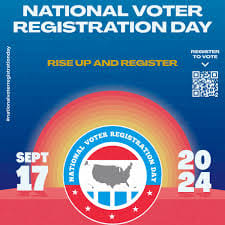Rafaela Prifti: National Voter Registration Day

September 17 is National Voter Registration Day. It is a nonpartisan civic holiday dedicated to celebrating democracy including the rights, responsibilties and opportunities we share as Americans. You can pick up a voter registration form or information about how to vote at several sites and official locations including your local library. If you are a newly naturalized American or first-time voter, there are online guides to voting that are accessable in the state of your residency. And if you have a few minutes to spare and are curious about voting rights history, here is a quick overview of healines going back to the 1700s.
1700s Voting was generally limited to white property holders: “Despite their belief in the virtues of democracy, the founders of the United States accepted and endorsed severe limits on voting. The U.S. Constitution originally left it to states to determine who is qualified to vote in elections. For decades, state legislatures generally restricted voting to white males who owned property. Some states also employed religious tests to ensure that only Christian men could vote.” Carnegie Corporation of New York.
1800s During the early part of the 19th century, state legislatures began to limit the property requirement for voting. However, many states, particularly in the South, used a range of barriers, such as poll taxes and literacy tests, to deliberately reduce voting among African American men.
1920 – After decades of organizing and activism, women nationwide won the right to vote with the ratification of the 19th amendment to the U.S. Constitution in 1920.
1960 Southern States ramp up barriers to voting.
1964 24th Amendment targets poll taxes. It was approved by Congress in 1962 and ratified by the states two years later. In a 1966 case, the Supreme Court ruled that poll taxes are unconstitutional in any U.S. election.
1965 Voting Rights Act passes Congress.
1971 President Nixon sign the 26th amendment bringing down the voting age to 18 from 21.
1975 Voting Rights Act expanded to protect language minorities.
1982 Congress requires new voting protections for people with disabilities.
1993 Congress passed the National Voter Registration Act known as “motor voter”. The law required states to allow citizens to register to vote when they applied for their drivers’ licenses. It also required states to offer mail-in registration and to allow people to register to vote at offices offering public assistance. In the first year of its implementation, more than 30 million people completed their voter registration applications or updated their registration through means made available because of the law.
2000 Election problems spotlight need for reform. The extremely close Bush-Gore Presidential race led to a recount in the state of Florida that highlighted the problems plaguing U.S. elections.
2002 Congress passes the Help America Vote Act.
2013 Supreme Court strikes a blow to the Voting Right Act
2014 Voting Right movement coalesces to fight supression.
2016 Presidential Election and claims of fraud. “After President Trump was elected despite losing the popular vote, he and his supporters made claims that large numbers of people voted illegally. The narrative about fraud ultimately resulted in President Trump convening the Presidential Commission on Election Integrity, which disbanded in January 2018 without presenting any evidence or findings.” Carnegie Corporation of New York.
November 2018 Election draws record number of voters, problems remain
Through 2020, there have been 59 presidential elections.
Currently on view, the Polonsky exhibition of the New York Public Library’s Treasures, includes objects and documents related to the history of democracy and civic life, among them a handwritten copy of the Bill of Rights from 1789.
Source: Carnegie Corporation of New York is an influential foundation established by Andrew Carnegie (1835–1919) in 1911 “to promote the advancement and diffusion of knowledge and understanding”.